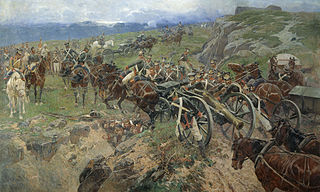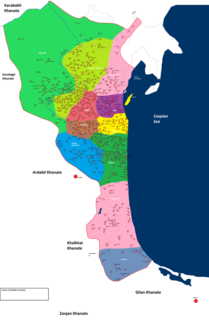 W
WThe khanates of the Caucasus, or Azerbaijani khanates or Persian khanates, or Iranian khanates, were various provinces and principalities established by Persia (Iran) on their territories in the Caucasus from the late Safavid to the Qajar dynasty. The Khanates were mostly ruled by Khans of Turkic (Azeri) origin and were vassals and subjects of the Iranian shah (King). Persia permanently lost a part of these khanates to Russia as a result of the Russo-Persian Wars in the course of the 19th century, while the others were absorbed into Persia.
 W
WBaku Khanate, was an autonomous Muslim principality under Iranian suzerainty, which existed between 1747 and 1806. Originally a province of Safavid empire, it became practically independent after the assassination of Nadir shah and weakening of central authority in Iran due to the struggle for power. Its territory now lies within present-day Azerbaijan,
 W
WAfter Nader Shah was assassinated in 1747, his nephew Ali Qoli seized the throne and proclaimed himself Adil Shah. He ordered the execution of all Nader's sons and grandsons, with the exception of the 13-year-old Shahrokh, the son of Reza Qoli. Meanwhile, Nader's former treasurer, Ahmad Shah Abdali, had declared his independence by founding the Durrani Empire. In the process, the eastern territories were lost and in the following decades became part of Afghanistan, the successor-state to the Durrani Empire. The Ottomans regained lost territories in Eastern Anatolia and Mesopotamia. The northern territories, Iran's most integral regions, had a different fate. Erekle II and Teimuraz II, who, in 1744, had been made the kings of Kakheti and Kartli respectively by Nader himself for their loyal service, capitalized on the eruption of instability, and declared de facto independence. Erekle II assumed control over Kartli after Teimuraz II's death, thus unifying the two as the Kingdom of Kartli-Kakheti, becoming the first Georgian ruler in three centuries to preside over a politically unified eastern Georgia. Due to the frantic turn of events in mainland Iran he would be able to remain de facto autonomous through the Zand period. Under the successive Qajar dynasty, Iran managed to restore Iranian suzerainty over the Georgian regions, until they would be irrevocably lost in the course of the 19th century, to neighbouring Imperial Russia. Meanwhile, Azad Khan Afghan managed to take control over the land between the Aras river, and the Urmia Lake by 1750. Azad Khan would later go on to capture Isfahan and occupy Shiraz, before losing all his territories by 1758 to Karim Khan. The Bakhtiari and Zand tribes moved back to their homeland and bickered with neighboring warlords over control of Western Iran. Meanwhile, the Absheron Peninsula and surrounding territories, were under the control of the Khanate of Baku, while the Avar Khanate took control over modern day Dagestan. Alongside eastern Georgia, these territories would all be re-incorporated into Iran but eventually permanently and irrevocably lost as well in the course of the 19th century, through the two Russo-Persian Wars of the century, to neighbouring Imperial Russia. Lastly, Oman and the Uzbek khanates of Bukhara and Khiva regained independence. The Afsharid dynasty would continue to live on in parts of Khorasan with Mashhad as the capital. When the Zand empire expanded rapidly, Karim khan allowed the Afsharids to continue rule in Khorasan, showing his respect for Nader Shah. It was eventually dissolved upon the Qajars ascension to the throne.
 W
WThe Sultanate of Elisu, also known as Elisou or Ilisu, was one of the Khanates of the Caucasus in the 18th and 19th centuries.
 W
WThe Ganja Khanate was a semi-independent Caucasian khanate that was established in Afsharid Iran and existed in the territory of what is modern-day Azerbaijan between 1747-1805. The principality was ruled by the dynasty of Ziyadoglu (Ziyadkhanov) of Qajar extraction as governors under the Safavids and Nadir Shah. Shahverdi Solṭan Ziyad-oglu Qajar became the khan of Ganja in 1554.
 W
WJavad Khanate was a khanate in the territory of modern Azerbaijan with its capital in the town of Javad. It extended from Javad on the Kura River southwest along the east side of the Aras River. It was bordered by Shamakhy Khanate (north), Karabakh Khanate (west), Karadagh khanate (southwest), Talysh Khanate (south), and Salyan Sultanate (east).
 W
WKaradagh Khanate, was a khanate established in the 18th century, with its capital being Ahar.
 W
WThe Nakhchivan Khanate was a khanate that was established in Afsharid Persia in 1747. The territory of the khanate corresponded to most of the present-day Nakhchivan Autonomous Republic and Vayots Dzor Province of present-day Armenia. It was named after its chief settlement, the town of Nakhchivan.
 W
WThe 1804–1813 Russo-Persian War was one of the many wars between the Persian Empire and Imperial Russia, and began like many of their wars as a territorial dispute. The new Persian king, Fath Ali Shah Qajar, wanted to consolidate the northernmost reaches of his kingdom—modern-day Georgia—which had been annexed by Tsar Paul I several years after the Russo-Persian War of 1796. Like his Persian counterpart, the Tsar Alexander I was also new to the throne and equally determined to control the disputed territories.
 W
WThe Russo-Persian War of 1826–1828 was the last major military conflict between the Russian Empire and Iran.
 W
WTalysh Khanate or Talish Khanate was a khanate of Iranian origin that was established in Persia and existed from the middle of the 18th century till the beginning of the 19th century, located in the south-west coast of the Caspian Sea.